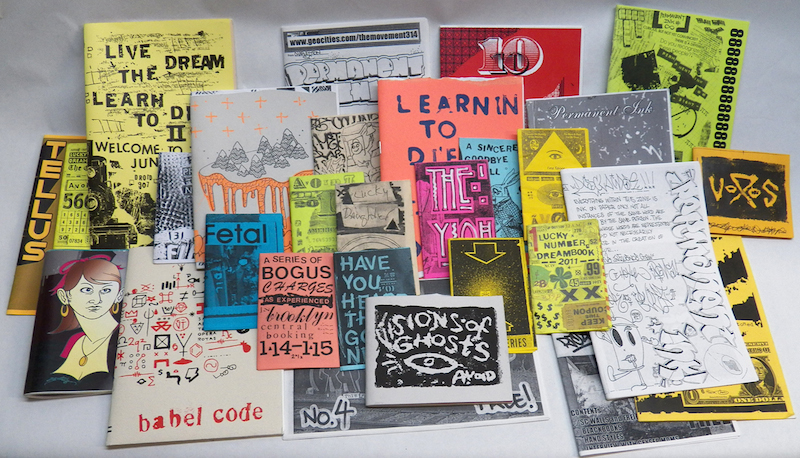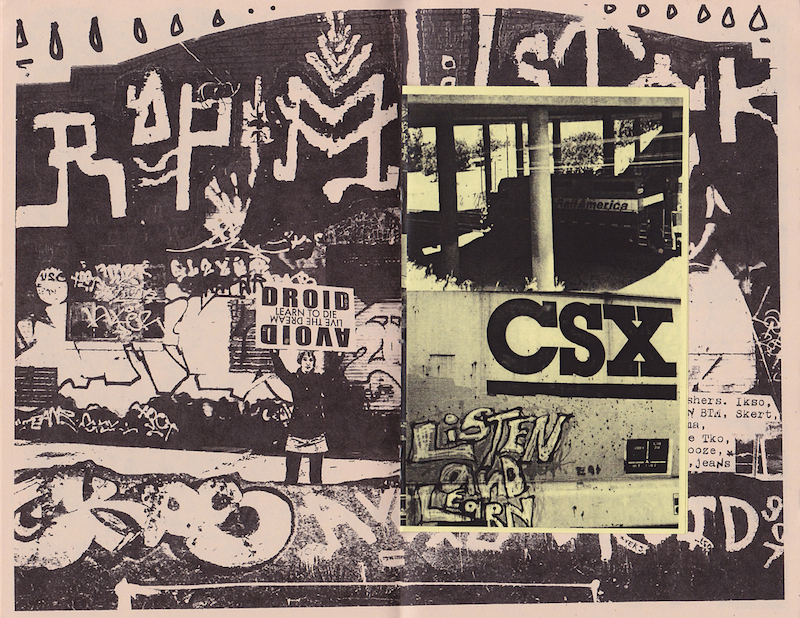
Various AVOID pi zines. Photo by Adam Void.
For Adam Void aka AVOID pi, zines have been an essential component of his graffiti practice since the late 1990’s. AVOID pi grew up in Columbia, South Carolina and went to college in Charleston, South Carolina. In Columbia, he was exposed to graffiti thanks to writers like KLEVER, and at college he was introduced to the work of Charleston native Shepard Fairey, which fit well with his interest in punk music and culture. Those influences formed the basis of his graffiti practice, and his interest in zines.
While AVOID pi plugged into the national graffiti scene as much as he could through connecting with out-of-town writers who visited Charleston and Columbia and got involved with flick trading, graffiti zines weren’t on his radar when he first started looking at photos of other peoples’ graffiti.
Before he had ever seen a graffiti zine, although they were certainly around, AVOID pi was picking up punk zines at concerts. Those punk zines and anarchist pamphlets (particularly Working Sucks by Tim Righteous) showed AVOID pi how easy it was to make your own zine. Inspired by those publications and graffiti magazines like Mass Appeal (which actually started as a zine in a suburb of Virginia)[1] and Life Sucks Die, AVOID pi was inspired to make his first zine in early 1999. It was called Permanent Ink and was full of AVOID pi’s photographs of graffiti in Charleston, which was graffiti that AVOID pi saw every day in the flesh but wasn’t seeing in major graffiti magazines like Mass Appeal. To distribute Permanent Ink, AVOID pi started sending bundles of the zine to his flick-trading contacts. The recipients would then give out some of the extra copies to friends or send them on to their own contacts. Whereas with flick trading AVOID pi would make five or so copies of each of his photographs and send out a selection to each of his contacts, now he could flood the graffiti community with his zines by the hundreds. As some of those secondary contacts got in touch with AVOID pi to ask for more copies of Permanent Ink or his future zines, his network began to grow to people whom he had never even met in person. People around the country were becoming aware of AVOID pi’s work and other graffiti in Charleston without ever having visited the city.
Through the contacts he was building up distributing his own zines, zines also started coming AVOID pi’s way. Some of those zines, like a freight-train zine out of Indianapolis called HRTA Journal, came from smaller cities without internationally recognized graffiti scenes and were sent to AVOID pi through his network of contacts. Other zines could be found in certain bookstores, such as 52.5 Records in Charleston which had zines out of San Francisco thanks to the publisher/distributor Last Gasp.
When he first started collecting them, zines kept AVOID pi plugged-in to a network of graffiti writers around the country even though he felt a bit isolated in South Carolina, but he thinks that zines were valuable for that same reason no matter what city you lived in. He says, “In some part, everyone was isolated. It doesn’t matter what city you were from, you were isolated, and zines were the way to communicate outside of that.”
Nearly 15 years since Permanent Ink, AVOID pi is still making zines. He has made around 50 zines and distributed an average 400 copies of each one, with $0 in profit for his work. In that time though, the culture has changed. Zines used to be distributed primarily through an internal distribution network, the occasional zine distributor and zine libraries. Those things still exist today, but the web has provided a platform for people to sell their zines directly to fans around the world. Until the internet came along, zines were the best, and perhaps only, way for the average artist or fan to document and share local work. Now, except for the case of people who are taking photos of their own illegal actions, the internet has without a doubt become the most logical way to share those flicks. As a result, the purpose of zines has shifted somewhat.
Today, AVOID pi says that zines are still important today for a few reasons: 1. As they always have been, zines are a material record documenting work from the past, since walls fade or get buffed, and now, websites disappear, but zines can stay on the shelf for decades; 2. Whereas digital data and websites can get artists arrested for putting up their illegal work, zines are much harder to trace and use in court cases; 3. With zines, artists and crews can distribute their own work on their terms rather than relying on another photographer to document the work and distribute the photos, as generally happens when pieces are posted online.

A spread inside of the zine Learn To Die Live The Dream II by AVOID pi and DROID 907. Scan by Adam Void.
The 4th and final reason that AVOID pi says zines are still important speaks the most to how zines have evolved since websites like Flickr have become popular. He argues that the internet has freed up zines to move from pure documentation to artworks. Although transition was already evident in some early zines such as spread in IGTimes, it is more and more common that zines are more than fans and artists publishing straightforward documentation in a DIY fashion. They have evolved to become artworks themselves.
Today, it’s probably easier and makes more sense for fans to upload their photos to Flickr than to make a zine, but blogs and tumblrs and Flickr photostreams are limited in their design. A zine allows for much more freedom. Looking at a contemporary zine by AVOID pi, you can see immediately why he chose to make a zine rather than just post photos online: He isn’t just putting photos on a page, he is making a document much greater than a tumblr. That’s not to say that tumblr pages cannot be artwork, but zines, by comparison, are unconstrained in their design and possibilities. AVOID pi’s most recent zines probably will not give you a great idea of the freshest pieces going up in his local scene, but, as artworks, they do so much more than that. AVOID pi can post photos on his website if he wants to show reality. With zines, he can make something new.
AVOID pi puts it best: “At one point, paintings were used to reflect the reality of the world. And then what came out? Photography. So then paintings went abstract, because they were freed from having to represent reality. I think that zines, at one point in time, were representing reality. When the internet came along and began serving that function, zines got freed up to be art pieces. Zines got abstracted. In much the same way that photography freed up painting, the internet freed up zines, and made them even more important and more valuable, because now zines are creative art objects.”
- "About." Mass Appeal. N.p., n.d. Web. 27 June 2012. <http://massappeal.com/about/>.↵